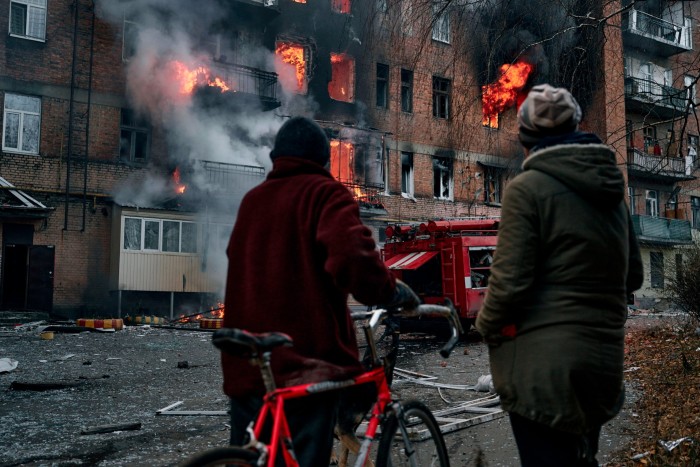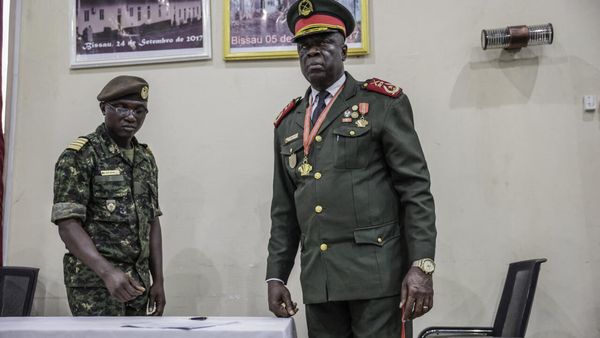
Rockets and mortars rained down on Ukrainian military positions on the eastern edge of the city of Bakhmut, spraying shrapnel and sending troops diving for cover.
Then came the Russian infantry, charging in a first world war-style attack across a no man’s land of shredded trees and artillery craters. The Ukrainians popped up and mowed down many of them with machine guns and grenade launchers.
Moments later, the scenes were repeated — although this time the Russian fighters had to navigate their comrades’ bodies. Again many were cut down by Ukrainian bullets.
“It’s like a conveyor belt,” Kostyantyn, an exhausted Ukrainian machine-gunner who described the scene to the Financial Times, said of the Russian tactics. “For what? A fucking metre of our land.”
The scene on Sunday in the frontline city of Donetsk province is one that troops say has played out repeatedly in recent days as Russia, desperate for a battlefield victory after humiliating defeats in Kharkiv and Kherson this autumn, refocuses its offensive in an area Russian president Vladimir Putin first invaded in 2014 and claimed to have annexed in September.
“They are just meat to Putin,” Kostyantyn added, referring to the Russian soldiers, “and Bakhmut is a meat grinder.”

The battle in the city began in May, heated up in August and has escalated significantly over the past two weeks. And yet the frontline has barely moved in seven months, with both sides fighting for mere metres of territory.
Ukrainian soldiers described the intensity of the recent fighting in and around Bakhmut, particularly the artillery barrages, as greater than anything they had experienced anywhere in Ukraine since the start of Russia’s full-scale invasion in February.
“A very fierce confrontation is ongoing there, every metre counts,” Ukrainian president Volodymyr Zelenskyy said in his Wednesday night address. During a visit to his troops 40km north-west of Bakhmut on Tuesday, he called the fighting around the city the “most difficult area that protects not only the east but our entire state”.
“Hell. Just hell,” is how Volodymyr, a senior officer who declined to give his last name because he was not authorised to speak to journalists, described the fighting. He was with a group of soldiers taking a short rest before returning to the battle.

“I’ll pray for you,” another soldier, manning a checkpoint on the city’s outskirts, told the FT after warning that the road ahead had been shelled moments before. “And you should pray for yourself.”
Until 2016, when Ukraine began a period of decommunisation, Bakhmut was named Artemivsk in honour of the Bolshevik revolutionary Fyodor “Artem” Sergeyev, a friend of Soviet leader Joseph Stalin. It has endured repeated military onslaughts: the Nazis seized it during the second world war before the Red Army retook it, and Russia’s proxy separatist forces briefly controlled it in 2014.
But with the fighting reminiscent of trench warfare, the city is experiencing an unparalleled level of death and destruction. Ukrainian fighters say it is a ghost town on its way to becoming a wasteland like nearby Izyum and the southern port city of Mariupol before it.
Once boasting a population of more than 70,000 and famous for its salt mines and sparkling wine factory, much of the city has been reduced to rubble after six months of air strikes and heavy artillery attacks. Fewer than 7,000 residents remain and they subsist mostly on humanitarian assistance. There is no power, water, gas or heating.
The city centre, which once bustled with a large outdoor market and cafés, is a fortress, with “hedgehog” angled metal bars and other anti-tank defences blocking the main avenues.
The only traffic is ambulances racing the wounded to medical points and tanks and other military vehicles trundling along chewed-up roads and through tangles of fallen electric tram lines.
Over the course of Monday morning when the FT visited, there was rarely more than five seconds between artillery explosions — on both sides of the frontline. The ground shook and the otherwise clear winter sky was hazy from the smoke. Russian drones could be heard buzzing overhead, apparently looking for targets.
Kyiv and Moscow have been tight-lipped about their casualties around Bakhmut but both are clearly suffering heavy losses. Each side has estimated they are killing dozens, if not hundreds, of enemy fighters every day but the true figures are impossible to verify.
Lidiya Vasylenko, a Ukrainian military press officer, said Russian forces had entered the city’s eastern outskirts in recent days. But she stressed that Ukrainian resistance and the harsh winter, which she said favoured her troops, were likely to minimise further gains.
“The ground is cold and hard, so even when they [Russian forces] take new forward positions, they have difficulty digging in deep enough to shelter themselves from our counter-attacks and they have to fall back,” she said.

Elite Ukrainian units, such as the 58th Motorised Infantry Brigade and 93rd Mechanised Brigade, have borne the brunt of the fighting, Vasylenko said. But reinforcements had been brought in over the past two weeks, including from Kherson, various special forces units, territorial defence outfits, and international legion troops, Vasylenko said.
Russia has done the same, moving forces from the Kharkiv and Kherson regions to Bakhmut.
British intelligence has said that members of the Wagner Group, founded by close Putin ally Evgeny Prigozhin, were leading the Russian charge in Bakhmut. Prigozhin has recruited fighters on visits to prison colonies in far-flung Russian regions.
Moscow’s autumn mobilisation campaign has also put more bodies on the ground. Putin said on Wednesday that 150,000 mobilised Russian troops were now in Ukraine, with half involved in active combat.
Some Ukrainian soldiers likened Russia’s strategy in Bakhmut to that in Luhansk province farther east earlier this year, where constant artillery barrages wore down Ukrainian forces and pulverised buildings, making their defence impossible.
Others said there seemed to be neither strategy nor logic to the Russian offensive beyond symbolism.

“Putin’s current fixation with continuing offensive operations around Bakhmut and elsewhere is contributing to Ukraine’s ability to maintain the military initiative in other parts of the theatre,” said the Institute for the Study of War.
Konrad Muzyka, director of Rochan Consulting, a Poland-based group that tracks the war, said Russian forces were “probably seeking to cut off a ground line of communication between Bakhmut and Kostyantynivka” — a town 25km to the west.
Signs of Russia’s attempted encirclement were evident on Monday, with fresh attacks north of Bakhmut towards the town of Soledar; south of the city at Opytne, where Russian forces managed to gain ground last weekend; and behind the front lines in the village of Ivanivske that sits along one of two key arteries leading to the city.
The FT witnessed the artillery barrage in Ivanivske, which struck several cottages and a farm building, causing fires to break out.
But Kostyantyn and Vasylenko both said they were confident Bakhmut would remain under Kyiv’s control through the winter.
That is of little consolation to the residents cowering in the remnants of their homes. Their nerves frayed, some wore fear on their faces, recoiling with each explosion. Others, hardened by months of fighting, barely flinched as they wandered the streets in a state of shock.
Vitaliy, a man in his 50s, said he was no longer afraid of dying. As a series of blasts rocked the city, he sat still on a bench in a square, sifting through a bag of food handed out at an aid centre.
He did not want to go home, he said, because it had been struck three times by artillery shells and was missing some of its walls. He blamed Ukrainian forces for the damage, saying they had moved into his neighbourhood and thus made it a target by bringing the war to his doorstep.
Kostyantyn, who had fought in Bucha near Kyiv in March where Ukrainian liberators had been greeted as heroes, said such an attitude was common.
“If they want to go to Russia, I’ll take them to the frontline and show them the way,” he said, gesturing to the battlefield.







